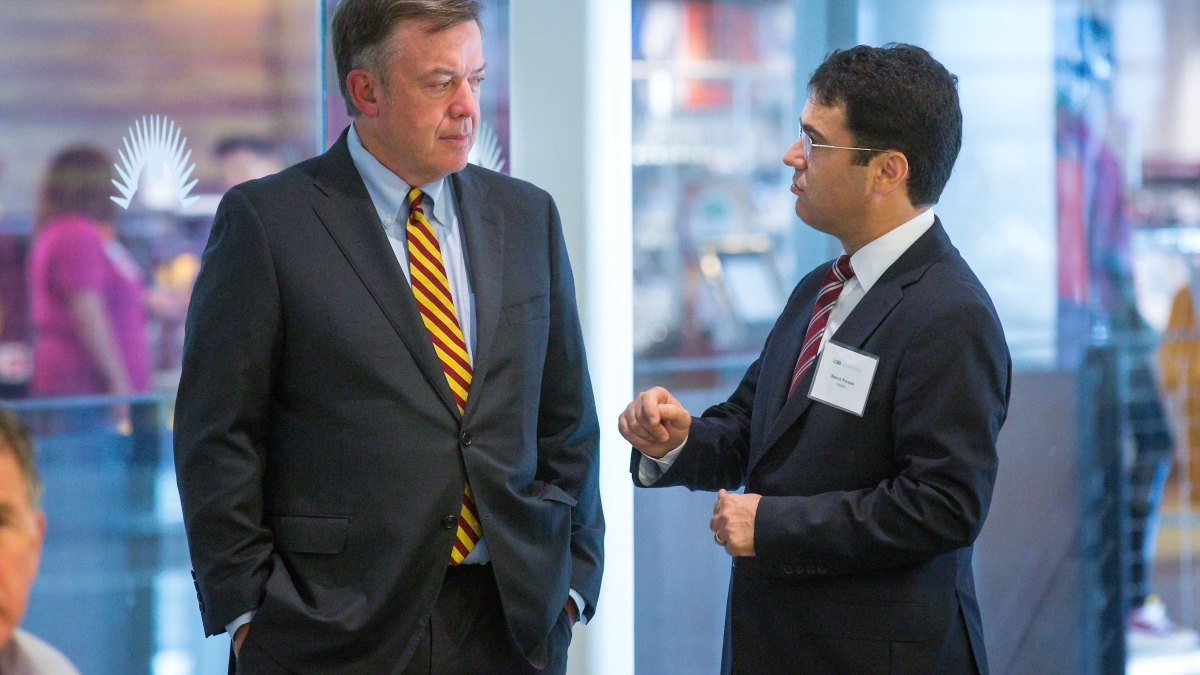The energy in the room was powerful.
Twenty men and women from around the world had traveled to Tempe, Arizona, for this moment. Alone, each might be able to change their own small corner of the globe. Together, they might one day change the world.
Eleven universities, one corporation — leaders in sustainability — working together to create sustainable outcomes on a global scale. It was clear from the dialogue over the course of their two days together that this was the goal of every founding member at the first-ever meeting of the Global Consortium for Sustainability Outcomes.
The challenge
When you’re a world leader in sustainability science, you know that the challenges are growing faster than their solutions. From poverty, terrorism and climate change to ocean acidification, food insecurity, water shortages and disease — the world is quickly recognizing how these problems negatively affect human well-being.
Universities are ideal places to develop and test solutions to these challenges. Often universities can implement solutions on a small scale with local partners. The nascent consortium empowers its members to achieve solutions on a global scale.
The founding meeting began Monday with a welcome from Arizona State University President Michael M. Crow, who described the depth of the challenge and his excitement to join forces with other universities to make sustainability both a value and an outcome.
Crow’s remarks harkened back to his 2002 inaugural address, when he spoke of crossing boundaries — both geographic and disciplinary — and transforming ASU into a university that “shapes its research initiatives with regard to their social outcomes.”
That charge has motivated the Julie Ann Wrigley Global Institute of Sustainability since its founding in 2004. It is the reason the university has joined like-minded partners in forming the consortium. ASU is a dues-paying member of the consortium and provides staff and operational support.
The consortium
The Global Consortium for Sustainability Outcomes (GCSO) is a global network that transforms ideas into action. What does success look like? It could be research that leads to a new solution, or an existing solution confirmed as functional or improved based on testing. It could be that a proven solution is implemented in a different location, industry sector or social context.
Equally important, success includes expanding capacity — whether enabling organizations and institutions to implement sustainability solutions or teaching students the skills they need to do so. It also includes submitting successful proposals for funding from other sources.
By joining together to form the consortium, members increase their global connections with partners who share a common desire to make sustainable change at a global scale. They increase their eligibility for funding from agencies around the world. They expand their pool of knowledge and skills.
Each member pays annual dues to the nonprofit, member-governed organization; 100 percent of membership dues are used to support member activities.
Near the end of the first day of meetings, Remus Pricopie, rector of the National University of Political Studies and Public Administration in Romania, expressed a sentiment echoed by many others in the room. His university did not join the consortium to compete against other consortium members for funding, Pricopie said. Rather, they joined because they expected to get their investment back many times over — not only financially, but also through the very real benefits of collaboration, international connectivity and the catalytic effect that contributes to sustainability impact.
“This could open up new possibilities for my institution, my country, the world,” Pricopie said.
The consortium is a new way of doing things, said Rob Melnick, executive director of the ASU Wrigley Institute. “No other university network fully focuses on sustainability outcomes, as GCSO was founded to do,” Melnick said. “This is not business as usual.”
ASU President Michael Crow (left) talks with Remus Pricopie, before a gathering of the founding members meeting of the Global Consortium for Sustainability Outcomes, on the Tempe campus, Tuesday, Oct. 25. Pricopie is from the National University of Political Studies and Public Administration in Romania. Photo by Charlie Leight/ASU Now
More Environment and sustainability

Saving the environment to save ourselves
Saving the environment.At Arizona State University, that's not just a trendy slogan. From water insecurity to wildfire awareness to cleaning pollutants in urban fishing waterways, ASU is…

'Earth Day Amplified' promotes power of collective action
Everybody loves the concept of sustainability. They want to do their part, and the chance to say they’ve contributed to the well-being our of planet.But what does that actually mean?Arizona State…

Rethinking Water West conference explores sustainable solutions
How do you secure a future with clean, affordable water for fast-growing populations in places that are contending with unending drought, rising heat and a lot of outdated water supply infrastructure…


